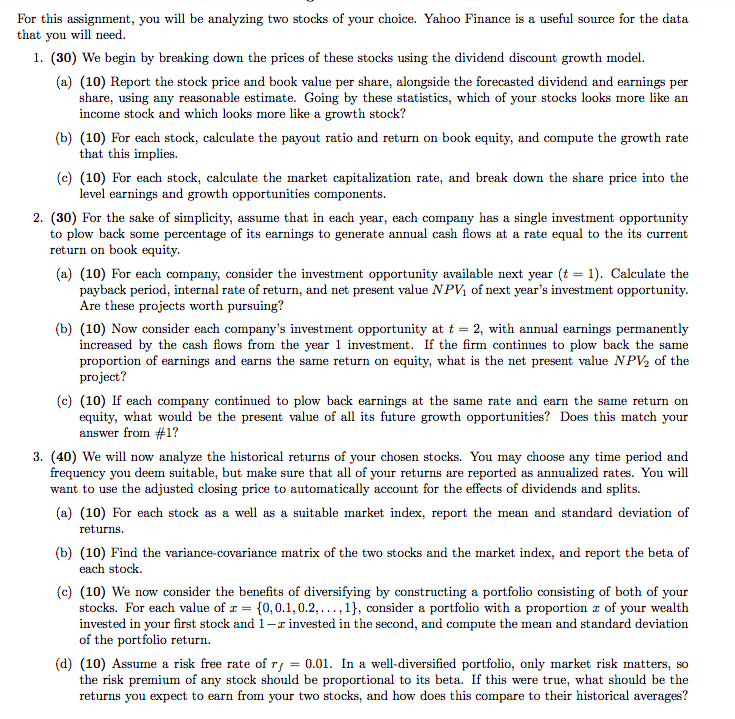
For this assignment, you will be analyzing two stocks of your choice. Yahoo Finance is a useful source for the data that you will need. 1. (30) We begin by breaking down the prices of these stocks using the dividend discount growth model. (a) (10) Report the stock price and book value per share, alongside the forecasted dividend and earnings per share, using any reasonable estimate. Going by these statistics, which of your stocks looks more like an income stock and which looks more like a growth stock? (b) (10) For each stock, calculate the payout ratio and return on book equity, and compute the growth rate that this implies. (c) (10) For each stock, calculate the market capitalization rate, and break down the share price into the level earnings and growth opportunities components. 2. (30) For the sake of simplicity, assume that in each year, each company has a single investment opportunity to plow back some percentage of its earnings to generate annual cash flows at a rate equal to the its current return on book equity. (a) (10) For each company, consider the investment opportunity available next year (t = 1). Calculate the payback period, internal rate of return, and net present value NPV1 of next year's investment opportunity. Are these projects worth pursuing? (b) (10) Now consider each company's investment opportunity at t = 2, with annual earnings permanently increased by the cash flows from the year 1 investment. If the firm continues to plow back the same proportion of earnings and earns the same return on equity, what is the net present value NPV, of the project? (c) (10) If each company continued to plow back earnings at the same rate and earn the same return on equity, what would be the present value of all its future growth opportunities? Does this match your answer from #1? 3. (40) We will now analyze the historical returns of your chosen stocks. You may choose any time period and frequency you deem suitable, but make sure that all of your returns are reported as annualized rates. You will want to use the adjusted closing price to automatically account for the effects of dividends and splits. (a) (10) For each stock as a well as a suitable market index, report the mean and standard deviation of returns. (b) (10) Find the variance-covariance matrix of the two stocks and the market index, and report the beta of each stock (c) (10) We now consider the benefits of diversifying by constructing a portfolio consisting of both of your stocks. For each value of r = {0,0.1,0.2,...,1}, consider a portfolio with a proportion 2 of your wealth invested in your first stock and 1-r invested in the second, and compute the mean and standard deviation of the portfolio return. (d) (10) Assume a risk free rate of rj = 0.01. In a well-diversified portfolio, only market risk matters, so the risk premium of any stock should be proportional to its beta. If this were true, what should be the returns you expect to earn from your two stocks, and how does this compare to their historical averages? For this assignment, you will be analyzing two stocks of your choice. Yahoo Finance is a useful source for the data that you will need. 1. (30) We begin by breaking down the prices of these stocks using the dividend discount growth model. (a) (10) Report the stock price and book value per share, alongside the forecasted dividend and earnings per share, using any reasonable estimate. Going by these statistics, which of your stocks looks more like an income stock and which looks more like a growth stock? (b) (10) For each stock, calculate the payout ratio and return on book equity, and compute the growth rate that this implies. (c) (10) For each stock, calculate the market capitalization rate, and break down the share price into the level earnings and growth opportunities components. 2. (30) For the sake of simplicity, assume that in each year, each company has a single investment opportunity to plow back some percentage of its earnings to generate annual cash flows at a rate equal to the its current return on book equity. (a) (10) For each company, consider the investment opportunity available next year (t = 1). Calculate the payback period, internal rate of return, and net present value NPV1 of next year's investment opportunity. Are these projects worth pursuing? (b) (10) Now consider each company's investment opportunity at t = 2, with annual earnings permanently increased by the cash flows from the year 1 investment. If the firm continues to plow back the same proportion of earnings and earns the same return on equity, what is the net present value NPV, of the project? (c) (10) If each company continued to plow back earnings at the same rate and earn the same return on equity, what would be the present value of all its future growth opportunities? Does this match your answer from #1? 3. (40) We will now analyze the historical returns of your chosen stocks. You may choose any time period and frequency you deem suitable, but make sure that all of your returns are reported as annualized rates. You will want to use the adjusted closing price to automatically account for the effects of dividends and splits. (a) (10) For each stock as a well as a suitable market index, report the mean and standard deviation of returns. (b) (10) Find the variance-covariance matrix of the two stocks and the market index, and report the beta of each stock (c) (10) We now consider the benefits of diversifying by constructing a portfolio consisting of both of your stocks. For each value of r = {0,0.1,0.2,...,1}, consider a portfolio with a proportion 2 of your wealth invested in your first stock and 1-r invested in the second, and compute the mean and standard deviation of the portfolio return. (d) (10) Assume a risk free rate of rj = 0.01. In a well-diversified portfolio, only market risk matters, so the risk premium of any stock should be proportional to its beta. If this were true, what should be the returns you expect to earn from your two stocks, and how does this compare to their historical averages







